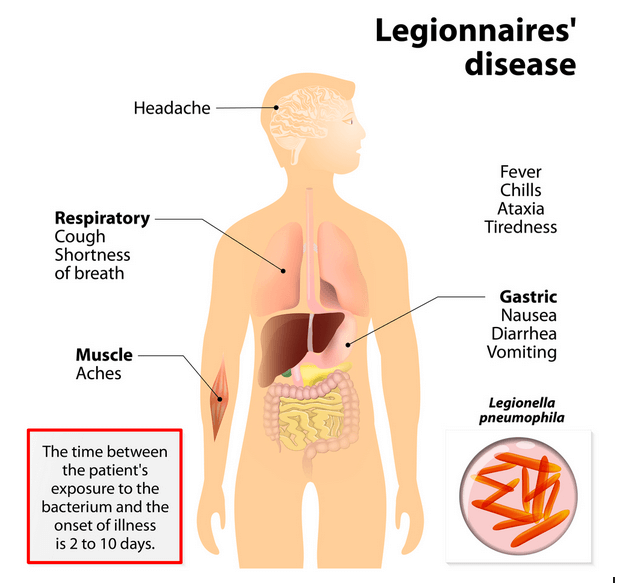Legionella and Legionnaires’ Disease
Legionnaires’ Disease is a potentially fatal illness that can be contracted from the Legionella bacteria in airborne water droplets. If your employees are at risk from Legionella you have a duty to protect them under the Health and Safety at Work etc Act 1974. In this guide we will be looking at what Legionella and Legionnaires’ Disease are, who might be at risk and how you can manage this risk as part of your health and safety management plan.
What is Legionella and Legionnaires’ Disease?
The term Legionnaires’ Disease was first coined in 1976, when there was an outbreak of pneumonia amongst attendees of a convention of the American Legion. Once the bacterium causing the pneumonia was identified, it was named Legionella. The group of illnesses caused by Legionella are collectively known as Legionellosis, with the most severe being Legionnaires’ Disease. Pontiac fever and Lochgoilhead fever are more mild complaints that are also caused by Legionella.
Legionnaires’ Disease is a potentially fatal form of pneumonia. The symptoms are similar to those of the flu and include:
- high temperature, fever and chills
- cough
- aching muscles
- headache

Image credit: Designua/Shutterstock.com
The disease then leads onto pneumonia and can very occasionally cause diarrhoea and signs of mental confusion. The illness does not spread from person to person and is treated with antibiotics.
If there is a chance that a case of Legionnaires’ Disease may have been acquired at your premises, you are legally required as the employer to report the incidence to the Health and Safety Executive.
Is there a risk of Legionnaires’ Disease in my workplace?
Your employees risk being exposed to Legionella if there’s a cooling tower or evaporative condenser, hot and cold water systems, or spa pool. Get more information on risk systems from the Health and Safety Executive.
Legionella is a naturally occurring bacterium that is normally found in water bodies such as rivers, lakes and reservoirs. However, it’s normally in such low concentrations that it’s not harmful. In a man made water system, such as may be found in a workplace cooling tower or hot water system, the conditions can be favourable for bacteria growth and Legionella can become a risk.
Everyone is susceptible to contracting Legionnaires’ Disease but healthy adults can normally be successfully treated with antibiotics and full recovery is expected. Legionnaires’ Disease is fatal in 5% to 30% of cases, with the elderly and infirm at most risk.
Those at higher risk are:
- Over 45s
- Smokers and heavy drinkers
- People suffering from chronic respiratory or kidney disease
- Diabetics
- People with lung and heart disease
- Anyone with an impaired immune system.
How does Legionnaires’ Disease occur?
If you breathe in small bacteria-containing droplets of water, which are suspended in the air, it is possible to contract Legionnaires’ Disease.
Water droplets possible to inhale can be created and dispersed by a cooling tower or water outlet. The growth of Legionella bacterium can be encouraged by favourable water temperatures in system, stored or re-circulated water, and/or deposits that feed bacterial growth – such as sludge or rust. Premises owners can take simple steps to reduce the risk of Legionnaires’ Disease by avoiding unfavourable conditions.
Employer responsibilities
Employers are responsible for managing risk in the workplace so that it’s a safe place to work. The Health and Safety at Work etc Act 1974, extends your duties to managing any possible risks from Legionella bacteria.
According to Healthy Working Lives, employers and/or those in control of premises should:
- identify and assess sources of risk
- prepare a scheme (or course of action) for preventing or controlling the risk
- implement and manage the scheme – appointing a person to be managerially responsible, sometimes referred to as the ‘responsible person’
- keep records and check that what has been done is effective
- if appropriate, notify the local authority of any a cooling tower(s) on site.
To be able to carry out a risk assessment, you or the person responsible for managing risks needs to understand the water systems in the premises inside out, to be able to work out if they are likely to create a Legionella exposure risk. You may need to appoint a contractor or consultant to conduct the risk assessment and prepare a course of action. The British Standards Institute have published a standard for legionella risk assessment.
The consequences of not properly controlling the risk of Legionella potentially include being responsible for fatalities and prosecution. In June 2015, the Brighton and Sussex University Hospitals NHS Foundation Trust, which runs the Royal Sussex County Hospital in Brighton, was fined £50,000 for failing to control Legionella. A joint investigation by the HSE and Sussex Police found there was a history of failing to manage “the deadly waterborne bug”.
How to reduce risks
To reduce the risk of exposure to Legionella it’s vital that you assess the risks and implement any necessary controls. As part of those controls you could consider switching to an alternative system; for example, a wet cooling tower could be replaced with a dry air-cooled system. You could also ensure water is kept hot, rather than warm, to kill the bacteria, and conduct routine sampling. For full guidance on the control of legionella bacteria in water systems visit the HSE website.
SAMS Ltd offers an assessment service for Legionnaires’ Disease and can put together a water management plan for you. Contact us today for more information.
